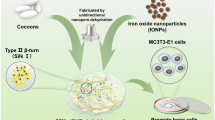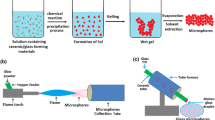Abstract
Bioactive glasses are widely used in biomedical applications due to their ability to bond to bone and even to soft tissues. In this study, borate based (13-93B3) bioactive glass powders containing up to 5 wt% Ce2O3 and Ga2O3 were prepared by the melt quench technique. Cerium (Ce+3) and gallium (Ga+3) were chosen because of their low toxicity associated with bacteriostatic properties. Bioactive glass scaffolds were fabricated using the polymer foam replication method. In vitro degradation and bioactivity of the scaffolds were evaluated in SBF under static conditions. Results revealed that the cerium- and gallium-containing borate glasses have much lower degradation rates compared to the bare borate glass 13-93B3. In spite of the increased chemical durability, substituted glasses exhibited a good in vitro bioactive response except when the Ce2O3 content was 5 wt%. Taking into account the high in vitro hydroxyapatite forming ability, borate glass scaffolds containing Ce+3 and Ga+3 therapeutic ions are promising candidates for bone tissue engineering applications.













Similar content being viewed by others
References
Hench LL. Bioactive materials: the potential for tissue regeneration. J Biomed Mater Res. 1998;15:511–8.
Brink M, Turunen T, Happonen R, Yli-Urppo A. Compositional dependence of bioactivity of glasses in the system Na2O-K2O-MgO-CaO-B2O3-P2O5-SiO2. J Mater Sci Mater Med. 1997;37:114–21.
Gerhardt LC, Boccaccini AR. Bioactive glass and glass-ceramic scaffolds for bone tissue engineering. Adv Mater. 2010;3:3867–910.
Rahaman MN, Day DE, Bal BS, Fu Q, Jung SB, Bonewald LF. Bioactive glass in tissue engineering. Acta Biomater. 2011;7:2355–73.
Hench LL, Thompson I. Twenty-first century challenges for biomaterials. J R Soc Interface. 2010;7:379–91.
Jones JR. Review of bioactive glass: from Hench to hybrids. Acta Biomater. 2013;9:4457–86.
Day DE, White JE, Brown RF, McMenamin KD. Transformation of borate glasses into biologically useful materials. Glass Technol Part A. 2003;44:75–81.
Liang W, Rahaman MN, Day DE, Marion NW, Riley GC, Mao JJ. Bioactive borate glass scaffold for bone tissue engineering. J Non-Cryst Solids. 2008;354:1690–6.
Yao A, Wang D, Huang W, Fu Q, Rahaman MN, Day DE. In vitro bioactive characteristics of borate-based glasses with controllable degradation behavior. J Am Ceram Soc. 2007;90:303–6.
Huang W, Day DE, Kittiratanapiboon K, Rahaman MN. Kinetics and mechanisms of the conversion of silicate (45S5), borate, and borosilicate glasses to hydroxyapatite in dilute phosphate solution. J Mater Sci Mater Med. 2006;17:583–96.
Fu Q, Rahaman MN, Fu H, Liu X. Silicate, borosilicate, and borate bioactive glass scaffolds with controllable degradation rate for bone tissue engineering applications. I. Preparation and in vitro degradation. J Biomed Mater Res, Part A. 2010;95A:164–71.
Gu Y, Huang W, Rahaman MN, Day DE. Bone regeneration in rat calvarial defects implanted with fibrous scaffolds composed of a mixture of silicate and borate bioactive glasses. Acta Biomater. 2013;9:9126–36.
Mouriño V, Cattalini JP, Boccaccini AR. Metallic ions as therapeutic agents in tissue engineering scaffolds: an overview of their biological applications and strategies for new developments. J R Soc Interface. 2011;9:401–19.
Jung S. Borate based bioactive glass scaffolds for hard and soft tissue engineering, Ph.D dissertation, Missouri University of Science and Technology. 2010.
Diba M, Tapia F, Boccaccini AR. Magnesium—containing bioactive glasses for biomedical applications. Int J Appl Glass Sci. 2012;3:221–53.
Jones JR, Ehrenfried LM, Saravanapavan P, Hench LL. Controlling ion release from bioactive glass foam scaffolds with antibacterial properties. J Mater Sci Mater Med. 2006;17:989–96.
Warrell RP, Bockman RS, Coonley CJ, Isaacs M, Staszewski H. Gallium nitrate inhibits calcium resorption from bone and is effective treatment for cancer-related hypercalcemia. J Clin Invest. 1984;73:1487–90.
Melnikov P, Teixeira AR, Malzac A, Coelho MB. Gallium-containing hydroxyapatite for potential use in orthopedics. Mater Chem Phys. 2009;117:86–90.
Sanchez-Robles MJ, Gamero-Melo P, Cortes-Hernandez DA. In vitro hydroxyapatite formation on the Ca doped surface of ZSM-5[Ga] type zeolite. Ceram Int. 2013;39:7387–90.
Verron E, Masson M, Khoshniat S, Duplomb L, Wittrant Y, Baud’huin M, Badran Z, Bujoli B, Janvier P, Scimeca J-C, Bouler J-M, Guicheux J. Gallium modulates osteoclastic bone resorption in vitro without affecting osteoblasts. British. J Pharmacol. 2010;159:1681–92.
Collery P, Keppler B, Madoulet C, Desoize B. Gallium in cancer treatment. Crit Rev Oncol/Hematol. 2002;42:283–96.
Franchini M, Lusvardi G, Malavasi G, Menabue L. Gallium- containing phosphor-silicate glasses: snythesis and in vitro bioactivity. Mater Sci Eng C. 2012;32:1401–6.
Keenan TJ, Wren AW, Coughlan A, Hall MM, Towler MR. The structural characterization of Ga2O3-Na2O-CaO-ZnO-SiO2 Bioactive glasses. IEEE .2012: 362–3.
Valappil SP, Ready D, Abou Neel EA, Pickup DM, O’Dell LA, Chrzanowski W, Pratten J, Newport RJ, Smith ME, Wilson M, Knowles JC. Controlled delivery of antimicrobial gallium ions from phosphate-based glasses. Acta Biomater. 2009;5:1198–210.
Bocacccini AR, Mourino V, Newby P. Preparation and characterization of gallium releasing 3-D alginate coated 45S5 bioglass based scaffolds for bone tissue engineering. Adv Eng Mater. 2010;12:B283–91.
Pickup DM, Moss RM, Qiu D, Newport RJ, Valappil SP, Knowles JC, Smith ME. Structural characterization by x-ray methods of novel antimicrobial gallium-doped phosphate-based glasses. J Chem Phys. 2009;130:064708.
Martens RJ, Miller NA, Cohen ND, Harrington JR, Bernstein LR. Chemoprophylactic antimicrobial activity of gallium maltolate against intracellular rhodococcus equi. J Equine Vet Sci. 2007;27:341–5.
Das S, Singh S, Dowding JM, Oommen S, Kumar A, Sayle T, Saraf S, Patra CR, Vlahakis NE, Sayle DC, Self WT, Seal S. The induction of angiogenesis by cerium oxide nanoparticles through the modulation of oxygen in intracellular environments. Biomater. 2012;33:7746–55.
Schubert D, Dargusch R, Raitano J, Chan S-W. Cerium and yttrium oxide nanoparticles are neuroprotective. Biochem Biophys Res Commu. 2006;342:86–91.
Zhang J, Liu C, Li Y, Sun J, Wang P, Di K. Effects of cerium ions on the proliferation, differentiation and mineralization function of primary mouse osteoblasts in vitro. J Rare Earths. 2010;28:138–42.
Goh Y-F, Alshemary AZ, Akram M, Abdul Kadir MR, Hussain R. vitro characterization of antibacterial bioactive glass containing ceria. Ceram Int. 2014;40:729–37.
Shruti S, Salinas AJ, Malavisa G, Lusvardi G, Menabue L, Ferrara C, Mustarelli P, Vallet-Regi M. Structral and in vitro study of cerium, gallium and zinc containing sol-gel bioactive glasses. J Mater Chem. 2012;22:13698–706.
Shruti S, Salinas AJ, Lusvardi G, Malavisa G, Menabue L, Vallet-Regi M. Mesoporous bioactive scaffolds prepared with cerium-, gallium- and zinc- containing glasses. Acta Biomater. 2013;9:4836–44.
Karakoti AS, Tsigkou O, Yue S, Lee PD, Stevens MM, Jones JR, Seal S. Rare earth oxides as nanoadditives in 3-D nanocomposite scaffolds for bone regeneration. J Mater Chem. 2010;20:8912–9.
Kokubo T, Kushitani H, Saka S, Kitsugi T, Yamamuro T. Solutions able to reproduce in vivo surface-structure changes in bioactive glass-ceramic A-W. J Biomed Mater Res. 1990;24:721–34.
Fu H, Fu Q, Zhou N, Huang W, Rahaman MN, Wang D, Liu X. In vitro evaluation of borate-based bioactive glass scaffolds prepared by a polymer foam replication method. Mater Sci Eng C. 2009;29:2275–81.
Haider A, Gupta KC, Kang I-K. Morphological effects of HA on the cell compatibility of electrospun HA/PLGA composite nanofiber scaffolds. BioMed Res Int. 2014;2014:308306.
Jones JR, Sepulveda P, Hench LL. Dose-dependent behavior of bioactive glass dissolution. J Biomed Mater Res A. 2001;58:720–6.
Lu HH, Pollack SR, Ducheyne P. 45S5 Bioactive glass surface charge variations and the formation of a surface calcium phosphate layer in a solution containing fibronectin. J Biomed Mater Res. 2001;54:454–61.
Kim H-M, Himeno T, Kawashita M, Kokubo T, Nakamura T. The mechanism of biomineralization of bone like apatite on synthetic hydroxyapatite : an in vitro assessment. J R Soc Interface. 2004;1:17–22.
Leonelli C, Lusvardi G, Malavasi G, Menabue L, Tonelli M. Synthesis and characterization of cerium-doped glasses and in vitro evaluation of bioactivity. J Non-Cryst Solids. 2003;316:198–216.
Liu X, Rahaman MN, DE Day. Conversion of melt-derived microfibrious borate (13-93B3) and silicate (45S5) bioactive glass in a simulated body fluid. J Mater Sci. 2013;24:583–95.
Deliormanlı AM. Size dependent degradation and bioactivity of borate bioactive glass. Ceram Int. 2013;39:8087–95.
Brown RF, Rahaman MN, Dwilewicz AB, Huang W, Day DE, Li Y, Bal BS. Conversion of borate glass to hydroxyapatite and its effect on proliferation of MC3T3-E1 cells. J Biomed Mater Res Part A. 2009;88A:392–400.
Fu Q, Rahaman MN, Bal BS, Bonewald LF, Kuroki K, Brown RF. Bioactive glass scaffolds with controllable degradation rates for bone tissue engineering applications, II: in vitro and in vivo biological evaluation. J Biomed Mater Res Part A. 2010;95A:172–9.
Zhang X, Jia W, Gu Y, Xiao W, Liu X, Wang D, Zhang C, Huang W, Rahaman MN, Day DE, Zhou N. Teicoplanin-loaded borate bioactive glass implants for treating chronic bone infection in a rabbit tibia osteomyelitis model. Biomaterials. 2010;31:5865–74.
Deliormanlı AM, Liu X, Rahaman MN. Evaluation of borate bioactive glass scaffolds with different pore sizes in a rat subcutaneous implantation model. J Biomater Appl. 2014;28:643–53.
Güder HS, Şahin E, Şahin O, Göçmez H, Duran C, Çetinkara HA. Vickers and knoop indentation microhardness study of β-sialon ceramic. Acta Phys Pol A. 2011;120:1026.
Srivastava AK, Pyare R. Characterization of CuO substituted 45S5 bioactive glasses and glass-ceramics. Int J Sci Technol Res. 2012;1:28–41.
Srivastava AK, Pyare R, Singh SP. In vitro bioactivity and physical-mechanical properties of Fe2O3 substituted 45S5 bioactive glass and glass-ceramics. Int J Sci Eng Res. 2012;3:1–15.
Acknowledgments
Support of Prof. Mohamed N.Rahaman (Missouri S&T, Rolla, USA) is greatly appreciated. The author would like to thank Xin Liu for technical assistance and Mehmet Yıldırım for performing microhardness measurements. The financial support for this research was provided by the Scientific and Technical Research Council of Turkey in the form of a TUBITAK 2219 fellowship and 1001 grant program for scientific and technological research projects; Grant No: 111M766.
Author information
Authors and Affiliations
Corresponding author
Rights and permissions
About this article
Cite this article
Deliormanlı, A.M. Synthesis and characterization of cerium- and gallium-containing borate bioactive glass scaffolds for bone tissue engineering. J Mater Sci: Mater Med 26, 67 (2015). https://doi.org/10.1007/s10856-014-5368-0
Received:
Accepted:
Published:
DOI: https://doi.org/10.1007/s10856-014-5368-0




